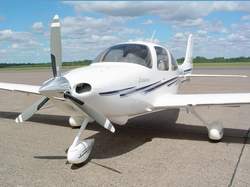Mon, Jul 20, 2009
Provides Guidelines For Electrical System Malfunction
 The FAA has published
a supplement to the Cirrus SR22 operators manual that provides the
necessary guidance for electrical load shedding in the event of the
primary electrical generating source failure in accordance with
§ 135.163(f)(2). The supplemental document outlines emergency
procedures in the event the pilot sees a steady Alt 1 light on the
panel, indicating an alternator failure.
The FAA has published
a supplement to the Cirrus SR22 operators manual that provides the
necessary guidance for electrical load shedding in the event of the
primary electrical generating source failure in accordance with
§ 135.163(f)(2). The supplemental document outlines emergency
procedures in the event the pilot sees a steady Alt 1 light on the
panel, indicating an alternator failure.
For aircraft serials with Avidyne PFD/MFD Avionics:
- Steady illumination indicates failure of alternator 1. Attempt
to restore alternator. If alternator cannot be restored, it will be
necessary to divert the flight to land within one hour.
- Loads on Main Buses, Non-essential Buses, and Air-conditioning
Buses must be reduced and available equipment on these buses
managed as necessary for flight conditions. Equipment essential for
continued safe flight and landing will be powered by Alternator 2
and Battery 2 through the Essential Buses. However, depending upon
flight conditions, additional equipment is required.
 A step-by-step list of
procedures follows those general instructions. For 14 CFR 135
Operations, FAA says the load shedding and equipment management in
the published procedure will provide at least one-hour operating
time on aircraft with a fully charged, 13.6 amp-hour battery
(available from Cirrus Design Spare Parts Sales) in good condition
for equipment required for emergency operation under 14 CFR
135.163(f), and meets the requirements of that paragraph. The
document instructs the pilot to replan the flight for a landing as
soon as practical (within one hour) at a landing field with visual
minimums. It says landing speed should be increased 10 KIAS
for flaps up and landing lights should not be used.
A step-by-step list of
procedures follows those general instructions. For 14 CFR 135
Operations, FAA says the load shedding and equipment management in
the published procedure will provide at least one-hour operating
time on aircraft with a fully charged, 13.6 amp-hour battery
(available from Cirrus Design Spare Parts Sales) in good condition
for equipment required for emergency operation under 14 CFR
135.163(f), and meets the requirements of that paragraph. The
document instructs the pilot to replan the flight for a landing as
soon as practical (within one hour) at a landing field with visual
minimums. It says landing speed should be increased 10 KIAS
for flaps up and landing lights should not be used.
For aircraft serials with Perspective PFD/MFD Avionics:
- Steady illumination indicates failure of alternator 1. Attempt
to restore alternator. If alternator cannot be restored, Alternator
2, and Bat 2 will provide sufficient electrical power to supply all
requirements for emergency operation of equipment indefinitely as
is required by 14 CFR 135.163(f).
And again, there are detailed instructions. FAA
says when the Cirrus Design SR22 aircraft is being operated under
the provisions 14 CFR 135, the Supplement is applicable and must be
inserted in the Supplements section (Section 9) of the Cirrus
Design SR22 Pilot's Operating Handbook (Handbook).
FAA says the information in the Supplement adds to,
supersedes, or deletes information in the basic handbook.
This is in no way the complete list of instructions
included in the 6 page supplement. ANN of course encourages SR22
pilots to familiarize themselves with the complete document as
issued by the FAA, and keep it in your airplane if required.
More News
Airbus Racer Demonstrator Makes Inaugural Flight Airbus Helicopters' ambitious Racer demonstrator has achieved its inaugural flight as part of the Clean Sky 2 initiative, a corners>[...]
A little Bit Quieter, Said Testers, But in the End it's Still a DA40 Diamond Aircraft recently completed a little pilot project with Lufthansa Aviation Training, putting a pair of >[...]
Line Up And Wait (LUAW) Used by ATC to inform a pilot to taxi onto the departure runway to line up and wait. It is not authorization for takeoff. It is used when takeoff clearance >[...]
Contributing To The Accident Was The Pilot’s Use Of Methamphetamine... Analysis: The pilot departed on a local flight to perform low-altitude maneuvers in a nearby desert val>[...]
From 2015 (YouTube Version): Overcoming Obstacles To Achieve Their Dreams… At EAA AirVenture 2015, FedEx arrived with one of their Airbus freight-hauling aircraft and placed>[...]
 Airbus Racer Helicopter Demonstrator First Flight Part of Clean Sky 2 Initiative
Airbus Racer Helicopter Demonstrator First Flight Part of Clean Sky 2 Initiative Diamond's Electric DA40 Finds Fans at Dübendorf
Diamond's Electric DA40 Finds Fans at Dübendorf ANN's Daily Aero-Term (04.23.24): Line Up And Wait (LUAW)
ANN's Daily Aero-Term (04.23.24): Line Up And Wait (LUAW) NTSB Final Report: Extra Flugzeugbau GMBH EA300/L
NTSB Final Report: Extra Flugzeugbau GMBH EA300/L Classic Aero-TV: 'Never Give Up' - Advice From Two of FedEx's Female Captains
Classic Aero-TV: 'Never Give Up' - Advice From Two of FedEx's Female Captains




